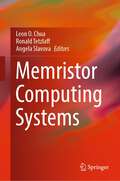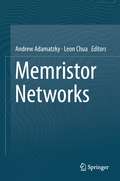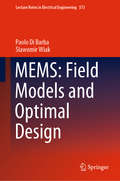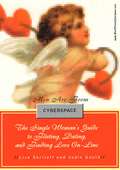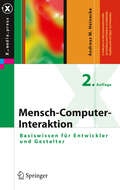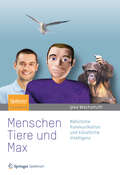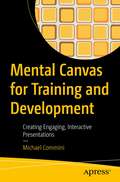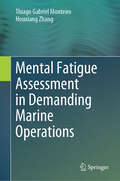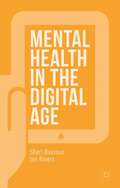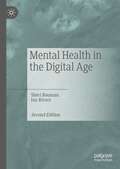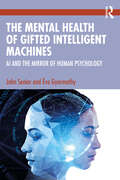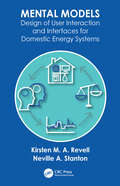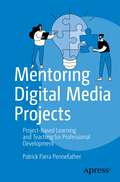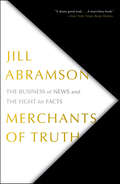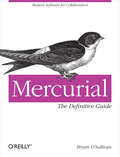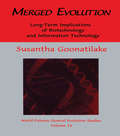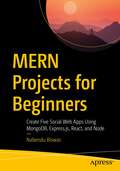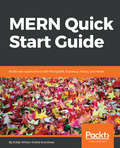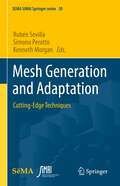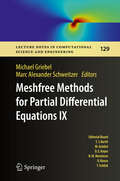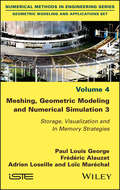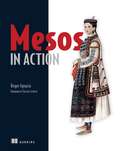- Table View
- List View
Memristor Computing Systems
by Leon O. Chua Ronald Tetzlaff Angela SlavovaThis contributed volume offers practical solutions and design-, modeling-, and implementation-related insights that address current research problems in memristors, memristive devices, and memristor computing. The book studies and addresses related challenges in and proposes solutions for the future of memristor computing. State-of-the-art research on memristor modeling, memristive interconnections, memory circuit architectures, software simulation tools, and applications of memristors in computing are presented. Utilising contributions from numerous experts in the field, written in clear language and illustrated throughout, this book is a comprehensive reference work. Memristor Computing Systems explains memristors and memristive devices in an accessible way for graduate students and researchers with a basic knowledge of electrical and control systems engineering, as well as prompting further research for more experienced academics.
Memristor Networks
by Andrew Adamatzky Leon ChuaUsing memristors one can achieve circuit functionalities that are not possible to establish with resistors, capacitors and inductors, therefore the memristor is of great pragmatic usefulness. Potential unique applications of memristors are in spintronic devices, ultra-dense information storage, neuromorphic circuits and programmable electronics. Memristor Networks focuses on the design, fabrication, modelling of and implementation of computation in spatially extended discrete media with many memristors. Top experts in computer science, mathematics, electronics, physics and computer engineering present foundations of the memristor theory and applications, demonstrate how to design neuromorphic network architectures based on memristor assembles, analyse varieties of the dynamic behaviour of memristive networks and show how to realise computing devices from memristors. All aspects of memristor networks are presented in detail, in a fully accessible style. An indispensable source of information and an inspiring reference text, Memristor Networks is an invaluable resource for future generations of computer scientists, mathematicians, physicists and engineers.
MEMS: Field Models and Optimal Design (Lecture Notes in Electrical Engineering #573)
by Paolo Di Barba Slawomir WiakThis book highlights numerical models as powerful tools for the optimal design of Micro-Electro-Mechanical Systems (MEMS). Most MEMS experts have a background in electronics, where circuit models or behavioral models (i.e. lumped-parameter models) of devices are preferred to field models. This is certainly convenient in terms of preliminary design, e.g. in the prototyping stage. However, design optimization should also take into account fine-sizing effects on device behavior and therefore be based on distributed-parameter models, such as finite-element models. The book shows how the combination of automated optimal design and field-based models can produce powerful design toolboxes for MEMS. It especially focuses on illustrating theoretical concepts with practical examples, fostering comprehension through a problem-solving approach. By comparing the results obtained using different methods, readers will learn to identify their respective strengths and weaknesses. In addition, special emphasis is given to evolutionary computing and nature-inspired optimization strategies, the effectiveness of which has already been amply demonstrated. Given its scope, the book provides PhD students, researchers and professionals in the area of computer-aided analysis with a comprehensive, yet concise and practice-oriented guide to MEMS design and optimization. To benefit most from the book, readers should have a basic grasp of electromagnetism, vector analysis and numerical methods.
Men Are From Cyberspace
by Lisa Skriloff Jodie GouldDon't dial up your Prodigy account without this one!Straight from the publishing vaults comes Men Are from Cyberspace, the finest online dating self-help book 1997 had to offer. All the Clinton-era single ladies agree, this classic tome will demystify the brave new world of romance on the information superhighway as it was meant to be (before Friendster and MySpace came along and ruined it). For anyone seeking an (ironic) trip down memory lane, you will learn the answers to such timeless questions as:* How do I find a newsgroup that's right for me?* What's the best way to make a chat-room entrance?* Are you a cyberaddict? Take this quiz and find out!Complete with a list of obsolete websites, usenets and cyber cafes, your entire romantic life will flash before your eyes as your read the (unintentionally) hilarious advice on virtual beaus, cybersex and other dating secrets for women in the "modern era". And if you ever wondered how your parents hooked up before Tinder, Men Are from Cyberspace: The Single Woman's Guide to Flirting, Dating, & Finding Love may provide some much needed insight about your mother's love life.
Mensch-Computer-Interaktion
by Andreas M. HeineckeJeder hat schon die Erfahrung gemacht, dass Webseiten nicht lesbar sind oder Programme unverständliche Meldungen hervorbringen. Kurz: Die Software ist nicht gebrauchstauglich. Ausgehend von der menschlichen Informationsverarbeitung legt der Autor dar, wie Schnittstellen beschaffen sein müssen und wie bei der Entwicklung vorgegangen werden muss, damit die Software gebrauchstauglich wird. Dabei werden neueste Normen und Vorschriften berücksichtigt. Die begleitende Website bietet weitere Beispiele und Übungsaufgaben, Lösungen und weiterführende Links.
Mensch und KI in Organisationen: Einfluss und Umsetzung Künstlicher Intelligenz in wirtschaftspsychologischen Anwendungsfeldern
by Melanie HasenbeinDieses Buch "Mensch und KI in Organisationen" zeigt Ihnen auf, welchen Einfluss die Künstliche Intelligenz und Robotik auf den Menschen in der aktuellen und zukünftigen Arbeits- und Organisationswelt hat. Das Werk nimmt Sie mit auf die Reise der Künstlichen Intelligenz in einzelnen psychologischen und wirtschaftspsychologischen Anwendungsfeldern.Auf der Basis von theoretischem Hintergrundwissen und aktuellen Studien sowie praktischen Umsetzungsmöglichkeiten erfahren Sie:wie Künstliche Intelligenz die Arbeits- und Organisationswelt verändert,was eine Mensch-KI-Interaktion und Mensch-Roboter-Interaktion kennzeichnet,wo KI und Roboter im Human-Resources-Bereich eingesetzt werden,welche zukünftigen Lernszenarien mit KI und Robotern möglich sind,wie eine hybride Führung und Teamarbeit zwischen Mensch, KI und Robotern aussehen kann und welche ethischen Grundsätze beim Einsatz von KI und Robotern zu berücksichtigen sind. Das Buch ist angereichert mit digitalen Fragen und Antworten, die Sie über die Flashcard App zum Selbsttest nutzen können. Die ZielgruppenProfessionals im Organisations- und Personalbereich, Berater, Trainer und CoachesStudierende der Wirtschaftspsychologie sowie der Angewandten und Digitalen Psychologie
Menschen, Tiere und Max
by Ipke Wachsmuth"Nur selten fragt die Wissenschaft nach dem roten Faden, der Lebendiges mit Technischem, Mensch mit Tier und beide mit Computern oder Robotern verbindet. Dieses lesenswerte Buch ist ein brillanter Führer durch den Themendschungel - und unerlässlich für jeden, der sich über den Stand der Forschung informieren will." Gert Scobel, 3sat"Was ist Kommunikation? Ein Pionier des digitalen Zeitalters nimmt uns mit auf eine spannende Reise: von Menschen und Tieren zu Computern und Robotern, die uns zunehmend ähneln und zugleich verändern und in Frage stellen. Wer sind wir, und wie werden wir künftig miteinander umgehen? Zugleich augenzwinkernd und tiefgründig und vor allem immer authentisch baut Ipke Wachsmuth beim Leser nicht nur Unwissen ab, sondern auch Ängste und Sorgen." Manfred Spitzer, Autor von "Lernen" und "Medizin für die Bildung"Wie gelingt Kommunikation? Unter welchen Voraussetzungen verstehen wir einander? Wie lernen Kleinkinder, sich zu verständigen? Wie kommunizieren Tiere untereinander und mit uns? Und schließlich: Können Roboter und virtuelle Agenten zu vertrauenswürdigen und einfühlsamen Dialogpartnern und Helfern werden? Ipke Wachsmuth führt den Leser auf einen spannenden Streifzug durch die Vielfalt und Komplexität der kommunikativen Fähigkeiten. Immer wieder begegnet uns dabei Max, ein Kunstmensch aus der virtuellen Realität, an dem sich ganz konkret das Funktionieren von Kommunikation und Fragen über die Möglichkeiten künstlicher Intelligenz erörtern lassen. Aus dem Epilog: Ich erwache, weil Max mich ruft. Von der schimmernden Wand, die ein einziges riesiges Display ist und die hinter ihm nun das Tagespanorama von Seoul zeigt, begrüßt er mich mit fröhlichem Gesicht: "Guten Morgen, Ipke, acht Uhr! Ausgeschlafen? Du hast doch um zehn Uhr einen Termin." ... Jetzt aber los. Halt, wie war das noch mit der freundlichen Begrüßung? "Max? Wie sagt man nochmal ,Guten Tag' in Korea?" Max sogleich: "An-nyeong ha-se-yo", und weiter: "Du musst in einer Viertelstunde aufbrechen." Also doch noch Zeit für ein wenig Entspannung. "Max, gib mal etwas Musik." Er kennt ja meine Lieblingsstücke, aus meinem iTunes. Max wählt ein Bluesstück aus und tanzt dazu. Ich greife zum Couchtisch, wo meine Bluesharp liegt, und jamme etwas, variiere das eine oder andere, bis es richtig groovt. _____ Möwen, Krabben und Marktschreier - ausgehend von Alltagsbeobachtungen beleuchtet Ipke Wachsmuth in diesem Buch die Themen Kommunikation, natürliche und künstliche Intelligenz. Es geht dabei um Sprache und Denken, um Mimik und Gestik - und um die Komplexität hinter den so alltäglich erscheinenden kommunikativen Fähigkeiten von Menschen und Tieren. Das Buch führt auch in die Welt von Robotern und anderen künstlichen Wesen ein, die unseren künftigen Alltag mehr und mehr bevölkern werden. Max ist ein "lebendes" Beispiel dafür, wie die Schnittstelle zwischen Mensch und Computer in Zukunft aussehen könnte. Doch wie erzeugt man ausdrucksvolle Sprache? Wie lassen sich Gesichtsausdrücke technisch nachahmen? Welche Rolle spielt der Sprechrhythmus für unsere Kommunikation? Wie ist die hochentwickelte Wortsprache des Menschen entstanden, die uns von allen Tieren unterscheidet? Bildgebende Verfahren machen es heute möglich, dem Hirn beim Denken "zuzuschauen" und damit auch Einblicke in die Prozesse des Sprachverstehens zu erlangen, die man mit künstlicher Intelligenz nachzuahmen versucht. Zu den weiteren Themen des Buches gehören Gebärdensprachen, der Zusammenhang von Zeichen und Bedeutung sowie die Wirkung von spontanen Körperbewegungen und Körperhaltung für die Übermittlung von Botschaften. Spannend ist die Frage, inwieweit Tiere und Menschen sich über Bedeutsames austauschen können. Sind Menschenaffen in der Lage, Symbole zu gebrauchen und absichtsvoll zu kommunizieren, verfügen sie vielleicht sogar über Bewusstsein? Und wird sich ein Maschinenwesen wie Max eines Tages mit uns aus der Perspektive eines eigenen "Ich" unterhalten können? Maschinen mit "Eigenleben" - kann es und soll es die geben? Könnten sie einfühlsame Partner des Menschen werden...
Mental Canvas for Training and Development: Creating Engaging, Interactive Presentations
by Michael ComminiTake advantage of layering and other digital techniques to create stunning, interactive compositions suitable for delivering instructional content and presentations on your iOS or Android device. This book shows you how to move from traditional paper and pen drawing to 3D content that can be interacted with by the viewer. Designed to be used on tablets, the Mental Canvas app is a reimagining of presentation software in the digital age that uses patented technology developed by a research team at Yale University. Whether producing concept drawings, storyboards, tutorials, sales presentations, or other forms of interactive media, you’ll learn the skills to transform boring presentations into something exciting and new! You’ll create stunning panoramic views; allow viewers to move through your artwork with multiple scenes; publish to the web for viewing on any smart phone, tablet, or computer; import image files; and export animated fly-throughs as .mp4 files. Mental Canvas can be used by individual creatives or as part of a collaborative design team sharing files between multiple devices giving global instructional design firms an edge over their competition. Provide fun, interactive, and engaging presentations and throw out those boring click-through, static presentations of the past. Business Dashboards, Organizational About Us pages, Sales presentations – virtually whatever the organization’s creatives can think up you’ll learn to develop in Mental Canvas!What You'll LearnUse layering to create stunning 3D effects in an otherwise static 2D imageImport and adapt existing images into your dynamic presentationCreate .mp4 fly-throughs that bring websites and presentations to life with videoWho This Book Is ForAny creative who wishes to build engaging and interactive presentations with their iOS or Android device.
Mental Fatigue Assessment in Demanding Marine Operations
by Houxiang Zhang Thiago Gabriel MonteiroThis book investigates how human mental fatigue (MF) can be objectively measured during demanding maritime operations. The maritime domain is characterized by demanding operations. These operations can be especially complex and dangerous when they require coordination between different maritime vessels and several maritime operators. The best approach to quantify MF is through the use of physiological sensors including electroencephalogram (EEG), electrocardiogram, electromyogram, temperature sensor, and eye tracker can be applied, individually or in conjunction, in order to collect relevant data that can be mapped to an MF scale. More than simpler sensor fusion, this book bridges the gap between relevant sensor data and a quantifiable MF level using both data-driven and model-based approaches. Data-driven part investigates the use of different NNs combined for the MF assessment (MFA) task. Among the different architectures tested, convolutional neural networks (CNN) showed the best performance when dealing with multiple physiological data channels. Optimization was used to improve the performance of CNN in the cross-subject MFA task. Testing different combinations of physiological sensors indicated a setup consisting of EEG sensor only was the best option, due to the trade-off between assessment precision and sensor framework complexity. These two factors are of great importance when considering an MFA system that could be implemented in real-life scenarios. The model-based discussion applies the current knowledge about the use of EEG data to characterize MF to develop an MF approach to quantify the progression of MF in maritime operators. In the research presented in this book, realistic vessel simulators were used as a platform for experimenting with different operational scenarios and sensor setups.
Mental Health in the Digital Age
by Sheri Bauman Ian RiversThe internet can now be reached by a fingertip on a smart phone and has changed our lives on a fundamental level. However, is mental health enhanced or diminished by this digitisation of our world? Innovation, such as digital technology, is often greeted with fear and suspicion but there is currently little evidence to support this. This book examines the intersection of mental health and digital technology in order to make informed decisions about the new options provided by the internet and technology. It highlights the rise in online therapy, self-help sites and social media as well as examining the ethical dilemmas involved in online research to suggest that the benefits created far outweigh the possible risks.
Mental Health in the Digital Age
by Sheri Bauman Ian RiversThis second edition of this highly impactful book examines the intersection of mental health and digital technology to make informed decisions about the new options provided by digital technology. It highlights the rise in online therapy and social media and examines the ethical dilemmas involved in online research to suggest that the benefits created far outweigh the possible risks. This expanded and updated second edition, includes practical suggestions for clinicians and public, builds upon the first by updating readers on recent developments in technology and research in this area since 2015. It explores ways in which governments and practitioners responded to the mental health crisis caused by the Covid-19 pandemic, and looks at the challenges as well as the benefits of our increasing interaction online.
The Mental Health of Gifted Intelligent Machines: AI and the Mirror of Human Psychology
by John Senior Éva GyarmathyThe Mental Health of Gifted Intelligent Machines explores the increasingly sophisticated behaviours of developing AI and how we can ensure it will have emotional resilience, ethical strength and an ability to think in a new and enhanced way. Its primary aim is to change how we understand the world by investigating humanity as an intelligent being, examining and contrasting human and artificial intelligence. The book considers what we can learn from the likely mental health issues that will occur with increasingly sophisticated aspects of machine intelligence and how they will reflect the human condition. It asks questions about our identity in a deeply uncertain and disruptive ever-changing world; how we will improve and enhance our psychological intelligence to meet the increasing complications and demands of the future; and what we need to do, now, to be psychologically intelligent enough to live a full meaningful life in a new world evolving around us. The book argues that changes in our understanding of mental health, psychology and our view of intelligence will challenge huge aspects of our fundamental beliefs and assumptions and that it is essential we explore new arenas to further understand both our own human psychological issues and mental health as we develop gifted intelligent machines. It is a must read for all students, researchers and professionals involved with AI, gifted education, consciousness and mental health.
Mental Models: Design of User Interaction and Interfaces for Domestic Energy Systems
by Kirsten M. Revell Neville A. StantonThere is a resurgence of interest in mental models due to advances in our understanding of how they can be used to help design and due to the development of practical methods to elicit them. This book brings both areas together with a focus on reducing domestic energy consumption. The book focuses on how mental models can be applied in design to bring out behaviour change resulting in increased achievement of home heating goals (reduced waste and improved comfort). This book also offers a method to extract and apply mental models to interface design. The approach enables mental models to be applied across domains when behaviour change was sought, and is validated as a useful design method.
Mental Models
by Indi YoungThere is no single methodology for creating the perfect product--but you can increase your odds. One of the best ways is to understand users' reasons for doing things. Mental Models gives you the tools to help you grasp, and design for, those reasons. Adaptive Path co-founder Indi Young has written a roll-up-your-sleeves book for designers, managers, and anyone else interested in making design strategic, and successful.
Mentoring Digital Media Projects: Project-Based Learning and Teaching for Professional Development
by Patrick Parra PennefatherMentoring is often a crucial, yet informal part of an organization’s best practices and skill development, whether targeted towards a team lead, project manager, designer, developer or a valued senior team member. This book provides practical strategies and methodologies for professionals to mentor others to successfully develop and deliver digital media projects across different types of settings.Many professionals working with teams in the digital media industry (games, web development, XR, IoT, mobile) are drawn to teaching others, but may not know how or where to start. Many might be a subject expert but may not have the structure and skills in place to be able to teach others effectively in workplace and institutional settings. This handbook will give professionals a guide on how to mentor junior designers, developers and other learners in formal and informal learning environments. Mentoring Digital Media Projects offers the right tools and strategies to use in digital media and emerging tech projects for you to better guide junior team members What You'll Learn Understand the difference between mentoring and teachingDesign thinking strategies to better identify where, when and how you can help and mentor othersBuild mentoring pipelines, end-to end, especially in post-secondary learning environmentsCreate emerging technology projects with teams Who This Book Is For Digital media professionals (game, web development, XR, mobile, IoT, etc.) who have experience working in teams in their specific discipline and who want to mentor others.
Merch Domination: The Ultimate Guide to Merch by Amazon
by Neil LMerch by Amazon has been the premier place for print on demand t-shirt designs since late 2015. This platform is easy to learn but hard to master. When you get the hang out if, Merch by Amazon can easily replace your full time income and could potentially lead to a nice six figure a year side income if you practice the lessons laid out in this Amazon Merch book. Learn from those who have done it before and continue to be some of the top power sellers on Merch. If you are interested in setting up a profitable Merch by Amazon t-shirt business, then you need to read the entire Merch Domination book. Within the hundreds of pages you will learn how to sell your custom artwork and novelty designs on Amazon with print on demand t-shirts. Take advantage of the biggest ecommerce retailer the world has ever known
Merchants of Truth: The Business of News and the Fight for Facts
by Jill AbramsonFormer executive editor of The New York Times and one of our most eminent journalists Jill Abramson provides a &“valuable and insightful&” (The Boston Globe) report on the disruption of the news media over the last decade, as shown via two legacy (The New York Times and The Washington Post) and two upstart (BuzzFeed and VICE) companies as they plow through a revolution that pits old vs. new media.&“A marvelous book&” (TheNew York Times Book Review), Merchants of Truth is the groundbreaking and gripping story of the precarious state of the news business.The new digital reality nearly kills two venerable newspapers with an aging readership while creating two media behemoths with a ballooning and fickle audience of millennials. &“Abramson provides this deeply reported insider account of an industry fighting for survival. With a keen eye for detail and a willingness to interrogate her own profession, Abramson takes readers into the newsrooms and boardrooms of the legacy newspapers and the digital upstarts that seek to challenge their dominance&” (Vanity Fair). We get to know the defenders of the legacy presses as well as the outsized characters who are creating the new speed-driven media competitors. The players include Jeff Bezos and Marty Baron (TheWashington Post), Arthur Sulzberger and Dean Baquet (TheNew York Times), Jonah Peretti (BuzzFeed), and Shane Smith (VICE) as well as their reporters and anxious readers.Merchants of Truth raises crucial questions that concern the well-being of our society. We are facing a crisis in trust that threatens the free press. &“One of the best takes yet on journalism&’s changing fortunes&” (Publishers Weekly, starred review), Abramson&’s book points us to the future.
Mercurial: The Definitive Guide (Animal Guide)
by Bryan O'SullivanThis instructive book takes you step by step through ways to track, merge, and manage both open source and commercial software projects with Mercurial, using Windows, Mac OS X, Linux, Solaris, and other systems. Mercurial is the easiest system to learn when it comes to distributed revision control. And it's a very flexible tool that's ideal whether you're a lone programmer working on a small project, or part of a huge team dealing with thousands of files. Mercurial permits a countless variety of development and collaboration methods, and this book offers several concrete suggestions to get you started. This guide will help you:Learn the basics of working with a repository, changesets, and revisions Merge changes from separate repositories Set up Mercurial to work with files on a daily basis, including which ones to track Get examples and tools for setting up various workflow models Manage a project that's making progress on multiple fronts at once Find and fix mistakes by isolating problem sources Use hooks to perform actions automatically in response to repository events Customize the output of MercurialMercurial: The Definitive Guide maintains a strong focus on simplicity to help you learn Mercurial quickly and thoroughly.
Merged Evolution: Long-term Complications of Biotechnology and Informatin Technology (World Futures General Evolution Studies #Vol. 14)
by Susantha GoonatilakeMerged Evolution charts the implications of two major forces of change, information technology and biotechnology, combined with a third force, that of 'artifactual' information, which is handed down dichronically from computing device to computing device.Through developments anticipated in the near future, Dr. Goonatilake describes the merging of these three systems, a convergence which will profoundly affect the biological, social, and technical fields much more than previous studies have implied. Together these changes yield an entirely different history - and a different future of the world for life, nature and civilization. This book addresses the broader issue arising from these important developments using the unifying perspective of general evolutionary theory to yield a fresh and profound insight.
MERN Projects for Beginners: Create Five Social Web Apps Using MongoDB, Express.js, React, and Node
by Nabendu BiswasLearn how to use the MERN stack (MongoDB, Express.js, React, and Node) to build five fully functioning web apps for dating, video sharing, messaging, and social media. While creating these web apps, you’ll learn key development concepts including how to use React hooks, Redux, MongoDB, Express, Heroku, Firebase, Material UI, and Google authentication. By expanding your portfolio with the projects you create, you will be well equipped as front-end developer. You will first create a dating site with a swiping feature and chat functionality. You will then build a video sharing app with videos displaying vertically. Next, you will learn to build an awesome messaging web app. Users will be able to chat in real time, as well as log in to their account using Google authentication. You will also create a photo sharing app and social media web apps with the ability to post images with captions and log in using email and password authentication. Most MERN tutorials out there today cover basic web apps but it is capable of so much more – learn how to use this stack to its full potential and build projects that can be converted into full scaled start-ups with additional features. What You'll LearnWork with React hooks and React routerExamine powerful MongoDB services for easy to use and setupCreate routes using Node and host on HerokuStudy different authentication techniquesDeploy all sites using simple Firebase hostingUse the powerful React ecosystem to add functionalities to your apps Who This book Is For Those who have just started their career in web development and have basic knowledge of the core web technologies: HTML, CSS, and JavaScript. Those with basic React development and feel ready to explore its capabilities further.
MERN Quick Start Guide: Build web applications with MongoDB, Express.js, React, and Node
by Eddy WilsonBuild web applications with MongoDB, ExpressJS, React, and NodeKey FeaturesBuild applications with the MERN stackWork with each component of the MERN stackBecome confident with MERN and ready for more!Book DescriptionThe MERN stack is a collection of great tools—MongoDB, Express.js, React, and Node—that provide a strong base for a developer to build easily maintainable web applications. With each of them a JavaScript or JavaScript-based technology, having a shared programming language means it takes less time to develop web applications. This book focuses on providing key tasks that can help you get started, learn, understand, and build full-stack web applications. It walks you through the process of installing all the requirements and project setup to build client-side React web applications, managing synchronous and asynchronous data flows with Redux, and building real-time web applications with Socket.IO, RESTful APIs, and other concepts. This book gives you practical and clear hands-on experience so you can begin building a full-stack MERN web application.Quick Start Guides are focused, shorter titles that provide a faster paced introduction to a technology. They are for people who don't need all the detail at this point in their learning curve. The presentation has been streamlined to concentrate on the things you really need to know.What you will learnGet started with the MERN stackInstall Node.js and configure MongoDBBuild RESTful APIs with Express.js and MongooseBuild real-time applications with Socket.IO Manage synchronous and asynchronous data flows with ReduxBuild web applications with React Who this book is forThe book is for JavaScript developers who want to get stated with the MERN Stack.
Mesh Generation and Adaptation: Cutting-Edge Techniques (SEMA SIMAI Springer Series #30)
by Rubén Sevilla Simona Perotto Kenneth MorganThe developments in mesh generation are usually driven by the needs of new applications and/or novel algorithms. The last decade has seen a renewed interest in mesh generation and adaptation by the computational engineering community, due to the challenges introduced by complex industrial problems.Another common challenge is the need to handle complex geometries. Nowadays, it is becoming obvious that geometry should be persistent throughout the whole simulation process. Several methodologies that can carry the geometric information throughout the simulation stage are available, but due to the novelty of these methods, the generation of suitable meshes for these techniques is still the main obstacle for the industrial uptake of this technology.This book will cover different aspects of mesh generation and adaptation, with particular emphasis on cutting-edge mesh generation techniques for advanced discretisation methods and complex geometries.
Meshfree Methods for Partial Differential Equations IX (Lecture Notes in Computational Science and Engineering #129)
by Michael Griebel Marc Alexander SchweitzerThis volume collects selected papers presented at the Ninth International Workshop on Meshfree Methods held in Bonn, Germany in September 2017. They address various aspects of this very active research field and cover topics from applied mathematics, physics and engineering.The numerical treatment of partial differential equations with meshfree discretization techniques has been a very active research area in recent years. While the fundamental theory of meshfree methods has been developed and considerable advances of the various methods have been made, many challenges in the mathematical analysis and practical implementation of meshfree methods remain.This symposium aims to promote collaboration among engineers, mathematicians, and computer scientists and industrial researchers to address the development, mathematical analysis, and application of meshfree and particle methods especially to multiscale phenomena. It continues the 2-year-cycled Workshops on Meshfree Methods for Partial Differential Equations.
Meshing, Geometric Modeling and Numerical Simulation 3: Storage, Visualization and In Memory Strategies
by Paul Louis George Frédéric Alauzet Adrien Loseille Loïc MaréchalTriangulations, and more precisely meshes, are at the heart of many problems relating to a wide variety of scientific disciplines, and in particular numerical simulations of all kinds of physical phenomena. In Volume 1, the theoretical foundations relating to triangulations, finite element shape functions and their interpretations as geometric patches were explored. This has made it possible to build tools that make the geometric modeling of any object possible. These elements are used in Volume 2 to treat meshing problems in their different implementations. Meshing, Geometric Modeling and Numerical Simulation 3 offers technical additions to the methods seen in the first two volumes and a significant portion of this book is dedicated to mesh visualization problems and solutions, especially those with a high degree of complexity.
Mesos in Action
by Roger IgnazioSummaryMesos in Action introduces readers to the Apache Mesos cluster manager and the concept of application-centric infrastructure. Filled with helpful figures and hands-on instructions, this book guides you from your first steps creating a highly-available Mesos cluster through deploying applications in production and writing native Mesos frameworks.Purchase of the print book includes a free eBook in PDF, Kindle, and ePub formats from Manning Publications.About the TechnologyModern datacenters are complex environments, and when you throw Docker and other container-based systems into the mix, there’s a great need to simplify. Mesos is an open source cluster management platform that transforms the whole datacenter into a single pool of compute, memory, and storage resources that you can allocate, automate, and scale as if you’re working with a single supercomputer.About the BookMesos in Action introduces readers to the Apache Mesos cluster manager and the concept of application-centric infrastructure. Filled with helpful figures and hands-on instructions, this book guides you from your first steps creating a highly-available Mesos cluster through deploying applications in production and writing native Mesos frameworks. You’ll learn how to scale to thousands of nodes, while providing resource isolation between processes using Linux and Docker containers. You’ll also learn practical techniques for deploying applications using popular key frameworks.What’s InsideSpinning up your first Mesos clusterScheduling, resource administration, and loggingDeploying containerized applications with Marathon, Chronos, and AuroraWriting Mesos frameworks using PythonAbout the ReaderReaders need to be familiar with the core ideas of datacenter administration and need a basic knowledge of Python or a similar programming language.About the AuthorRoger Ignazio is an experienced systems engineer with a focus on distributed, fault-tolerant, and scalable infrastructure. He is currently a technical lead at Mesosphere. Table of ContentsPART 1 HELLO, MESOSIntroducing MesosManaging datacenter resources with MesosPART 2 CORE MESOSSetting up MesosMesos fundamentalsLogging and debuggingMesos in productionPART 3 RUNNING ON MESOSDeploying applications with MarathoNManaging scheduled tasks with ChronosDeploying applications and managing scheduled tasks with AuroraDeveloping a framework
